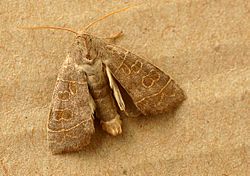| Ipimorpha subtusa | |
|---|---|
 | |
| Scientific classification | |
| Kingdom: | Animalia |
| Phylum: | Arthropoda |
| Class: | Insecta |
| Order: | Lepidoptera |
| Superfamily: | Noctuoidea |
| Family: | Noctuidae |
| Genus: | Ipimorpha |
| Species: | I. subtusa |
| Binomial name | |
| Ipimorpha subtusa (Denis & Schiffermüller, 1775) | |
Ipimorpha subtusa, the olive, is a moth of the family Noctuidae. It is found in the Palearctic realm (Europe, Russia, Turkey, Siberia, Russian Far East, Mongolia, China, Korea, and Japan).
Contents

